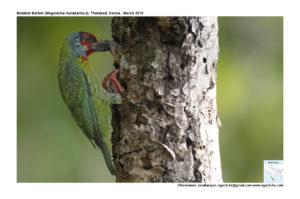Malabar Barbet

Malabar Barbet Megalaima malabarica
Etymology:
- Megalaima: Greek word megalos- great; laimos- throat. { Great Throat}
- Malabarica: From Malabar region in India
Vernacular Names: Ta: Chinna kukkuruvan, Te: Tokoji, Mal: Alekili, Sinh: Mal kottoruwa, Mar: Lal Khanthacha Tambat
Distribution in India: Resident of Western Ghats in India.
Description: Size of 16–17 cm; Wt. of 38–42·5 g. This is a small, chunky, green Barbet with reddish legs and feet. The male is larger , has red of forehead extending over forecrown and over entire face, malar and throat to breast, sometimes shows faint streaking below, and has black bill. The juvenile is dull green, with bluish rump, lacks adult face pattern, blue of head is replaced by grey and red is replaced by yellow, as well as solid green underparts.
Habitat: It is found in evergreen forest, forest edges, plantations of fruiting trees, and remnant forest patches, extending into agricultural areas with trees and gardens; it is found up to 1200 m.
Food habits: It eats fruits like fig species and berries. They also eat small insect l during nesting.
Breeding habits: They breed in Dec–May in India. They are double-brooded; laying again 4–6 days after first brood has fledged. They exhibit courtship feeding. The nest is excavated by both adults, for 18 days, above ground in underside of thin branch, often below previous year’s nest. They lay a clutch of 2–3 eggs, laid within 3–5 days. The female incubates at night, both sexes incubate by day, and change-overs indicated with “cheen” calls. The incubation period is 14–15 days. Both adults feed young, regurgitate insects and fruits for 4 days, and then shift to fruits. The chicks are fed at rate 2–4 feeds per hour, increasing to 13 per hour before fledging. The fecal sacs are removed first hourly, later 5 times an hour. The fledging period is 35–37 days.